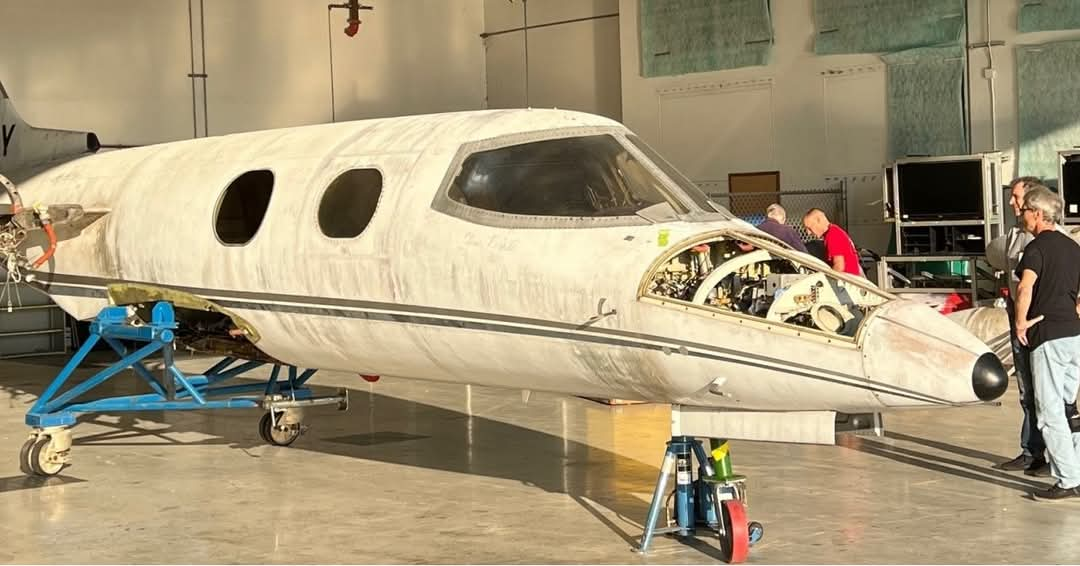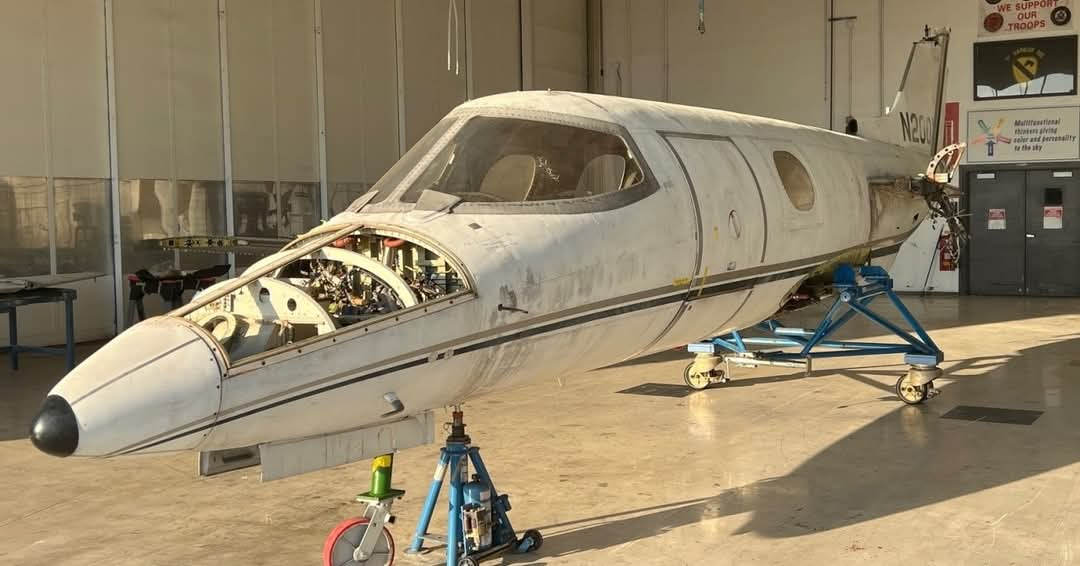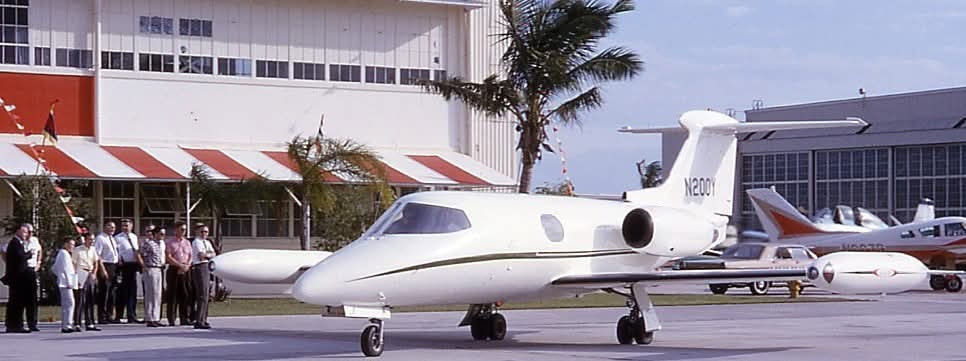The Restoration of Lear 23-003: Reviving a Legendary Jet in Aviation History

First LearJet
It can be confidently stated that the Learjet is the forefather of today’s multibillion-dollar business aviation industry. When the first Lear 23 was introduced in 1964, it was immediately embraced by celebrities and industry leaders, creating the private jet market and turning the name "Lear Jet" into a symbol of new freedom and travel privileges.
Lear 23-003—the first delivered aircraft of the Learjet family—has now returned to its birthplace in Wichita, where an ambitious program has begun to restore it to flying condition. In May 2023, the aircraft was acquired by the Classic Learjet Foundation (CLF), a nonprofit organization founded by former and current aviation industry employees with the goal of restoring 003 to the condition it was in when it was originally delivered in 1964.

Restoration
Richard Kovitch, the group’s historian, tracked the plane’s journey. “Around 2018, I was informed that it was no longer registered,” Kovitch recalls. “That news piqued my curiosity, and I wanted to find out where the aircraft was and what would happen to it.” His search concluded in February 2022, when the father of the aircraft’s owner contacted him, asking if he knew anyone interested in buying it. In July 2022, the team that would later form CLF traveled to Florida to assess the aircraft’s condition. It had been stored outdoors for over a decade at Bartow Executive Airport near Tampa.
The rudder had been damaged by Hurricane Ian, a Category 5 storm, but the aircraft had been tightly sealed during its years of inactivity and had not become home to any stowaway animals. Later, after inflating the tires and moving the aircraft into a hangar, they powered up Lear 23-003, and the cockpit lights turned on.

“The plane was fully intact—the instrument panel, gauges, everything was there,” Kovitch recalls. “We didn’t attempt to start the engines since they had been outside for 10–12 years, but we concluded that the aircraft was worth restoring.”
A brief inspection of the records showed that the last flight had taken place over two decades ago. “The last recorded maintenance was in 1998. There was one more log entry in 1999—by then, it had just under 5,900 flight hours—so we believe it was flown until its landing gear and engines became inoperative, at which point it was parked,” says Bill Kinkade, the foundation’s president.
After lengthy negotiations, both parties agreed on a purchase price of $90,000, although the original asking price was $250,000. “We were dealing directly with the actual owner. We were honest with him and said that no one was going to pay a quarter-million dollars for this plane,” Kinkade explains, adding that the owners were aware of the aircraft’s significance and knew that someone would eventually come for it. “They had time invested in the plane—they preserved it for 25 years—so they deserved compensation for their efforts.”
In the end, the owner agreed that the aircraft should be preserved. “I think we convinced them that we were probably their best option,” Kinkade continues. “We are all passionate, we are all enthusiasts, and we have the connections and technical expertise to raise the funds and get the aircraft flying again. So, we reached a fair agreement that I don’t think the owner would have found with another buyer.”
Given the aircraft’s pedigree and historical significance, some might assume that it should have gone to the Smithsonian National Air and Space Museum in Washington, D.C. However, that institution already has Learjet 002, which was used for flight testing and was acquired directly from the manufacturer (Learjet 001 was lost in a flight test accident in 1964).
Once the price for 003 was settled, the foundation provided an initial payment, which led to the release of the aircraft’s GE CJ610-1 engines and maintenance records. These were sent directly to International Turbine Industries in Michigan for restoration. The company will upgrade them to CJ610-4 standards as an in-kind donation.
One of the most valuable aspects of the acquisition is the aircraft’s complete set of logbooks, dating back to its delivery, making them a sort of time capsule. “Lyman Yandell was the chief inspector at Learjet in the earliest days, and his name is in the logbook,” Kinkade notes. “He was the one who originally certified the aircraft as flight-worthy in 1964.”
The aircraft’s fuselage was disassembled for transport to Wichita, the self-proclaimed “Aviation Capital of the World,” where it was built nearly six decades ago and where the foundation was officially established in September of last year. The wings were removed, and the fuselage was placed in a special cradle. Both arrived in Kansas on a flatbed truck in late February. Bombardier, which acquired Learjet in 1990, donated storage space for the aircraft in Building 14 of its complex—the same building where Learjet deliveries were once made.

A significant portion of the restoration work will be done by industry volunteers. The foundation expects many current and retired aviation professionals to participate, some of whom even worked on the Lear 23 assembly line in its early days. However, it is unclear how long the restoration will take.
“If we were dealing with a Lear 23 that had been in service and just came off the line, we’d be talking about six to eight months, but this is not that kind of aircraft,” Kinkade explains. “We know the wing might have issues, and until we X-ray it, inspect it, and clean it, we honestly can’t predict a timeline.” Depending on how smoothly the process goes, estimates range from three to five years.
With Learjet production ceasing in 2021, Bombardier salvaged and donated a Learjet wing assembly jig from the now-defunct assembly line to help address potential structural issues. Currently in storage, the unit weighs 15 tons when fully assembled.
Regarding other necessary parts, the foundation has located several Lear 23 airframes in two known scrapyards. “I’ve gone through a lot of old fuselages and know there are many usable parts we can probably acquire,” says Weber. “Both owners of these facilities have verbally assured me that we can take whatever we need.”
The aircraft’s interior was replaced at least once during its service life, and the team’s goal is to restore it to its factory-standard appearance. “We want to go back to the original,” Kinkade says. “Another advantage is that we have access to a vast archive of technical, marketing, and sales data to help guide the restoration.” He also notes that local service providers have stepped up: “We didn’t even have to ask—once they heard this was happening, they volunteered to handle the interior.” Similar offers have been made for windows and exterior painting.
While the cockpit is intact, CLF acknowledges that some updates will be necessary. “I think the foundation wants us to keep it as original as possible, but safety considerations and operational restrictions may require some modifications,” Weber says.
Additionally, a decision will need to be made about whether to bring the aircraft into compliance with modern noise regulations. “We have two possible paths: installing a noise suppression kit or obtaining an FAA exemption through historical flight programs,” Kinkade explains. “We can’t start the exemption paperwork until the aircraft is officially registered under the foundation’s name.”

One major hurdle that has already been overcome is reclaiming the aircraft’s original N-number, N200Y. Over its long service life, the plane changed registrations, and the number it had upon delivery was reassigned to a Louisiana-based Cessna Sovereign. “After months of persistent persuasion and pleading, I got them to agree to release the N-number to us,” Weber says. In exchange, the foundation had to arrange for a personalized registration number that satisfied the Cessna’s owner. As a backup, the foundation also secured the aircraft’s original test flight number, 003.
The foundation includes two type-rated pilots, one of whom was a marketing operations pilot for Learjet, while the other was a production test pilot.
Since no other Lear 23s remain in active service, the group hopes to showcase 003 at airshows like EAA AirVenture and Sun 'n Fun, allowing people to see, hear, and experience how the first purpose-built business jet looked and flew.
With the aircraft, the foundation aims to tell the story not only of Bill Lear and the team that designed a jet synonymous with private luxury travel in the 1960s and 1970s but also of entrepreneurship and technological advancement. “Marketing and celebrity endorsements are just as relevant in today’s economy,” Marshall notes. “We want to incorporate these elements into educational programs to inspire students to pursue careers in technology and aviation.”
The foundation also presents 003 as a symbol of Wichita’s proud aviation history. “We believe this aircraft set the standard for all business jets delivered from Wichita,” Weber states.

TriStar inspires!
It Might Also Be Interesting

Subscribe Now to TriStar Blog
Zero spam. Unsubscribe at any time.

TriStar 24/7 Call Center
E-Mail Support
TriStar Charters & Concierge arranges flights on behalf of our clients with FAA Certified FAR Part 135 direct air carriers that exercise full operational control of charter flights at all times. All flights purchased on our platform will be operated by FAR Part 135 direct air carriers that have been certified to provide service for the TriStar Charters & Concierge company clients and that meet all FAA safety standards. Your itinerary will clearly state the name of the certified operator conducting your flight.




